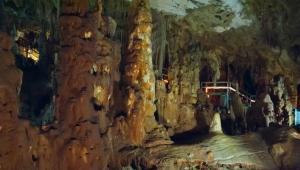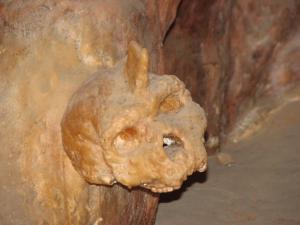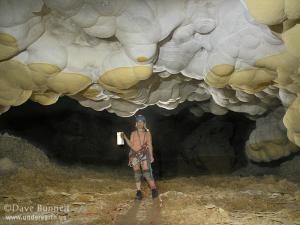Scholars have long debated the age of a human-like skull discovered in Petralona Cave in northeastern Greece, but have overlooked evidence suggesting the cave and its extraordinary natural formations may be the oldest known sacred site in human history.
Sometimes the awe-inspiring natural features of a cave appear custom-made to reinforce the cosmological beliefs of those who discover them. Natural cave formations that seemed to reflect core religious beliefs were perceived as divine manifestations of the gods.
For example when the Maya discovered a natural column formed by a stalagmite joined with a stalactite in Balamkanche Cave in the Yucatan, they established a shrine to the Mayan creator Xibalba, who raised the ceiba tree to the heavens at creation. In Ethiopia, the Sof Omar Caves feature natural columns, buttresses, domes, vaults and pillars that inspired Sheikh Sof Omar to establish a mosque there in the 12th century.

The sacredness of Petralona Cave
Filled with astonishing natural formations, Petralona Cave in Greece was once known as the Cave of the Red Stones, and likely perceived as a divine manifestation. The red color of its natural columns would have been perceived as the immortal blood of creator gods A rare phenomenon known as mammilaries or “cave clouds” on the ceilings were produced by rocks super-saturated with calcium carbonate. The cloud-like stone ceilings creates the impression that the cave is a microcosm or model of the outside world.
Petralona Cave also features human-like fossil remains dating back 800,000 years, making the cave a prime candidate for the oldest known sacred site in the world.
Meanwhile, scholars have been debating for decades whether a skull found in the cave is 700,000 years old or closer to 200,000 years old. Not only is the age of the Petralona Skull in dispute, so is the species it belonged to. The skull has been variously identified as Homo erectus, Homo heidelbergensis, Homo neanderthalensis or an early form of Homo sapiens.
While the Petralona Skull has made international headlines over the years, evidence suggesting the cave was once a profoundly sacred place has been overlooked, despite truly fascinating evidence. In addition to the mysterious human-like remains, archaeologists found 25 species of birds, none of which would be likely to wander into a cave and die.

The signifiance of ‘cave clouds’
But the obvious conclusion that people intentionally brought birds into the cave partly because of the “cave clouds” isn’t the kind of deduction typically embraced by western scholars. On the other hand, Petralona Cave is located on a major seasonal ground for migratory birds, and our distant ancestors were known to favor such habitats. And recent studies found Neanderthals gathered birds in caves across Europe and used their feathers and talons as personal ornaments in symbolic rituals, according to Clive Finlayson’s The Smart Neanderthal: Cave Art, Bird Catching, and the Cognitive Revolution (Oxford University Press, 2019).

It was no surprise when archaeologists excavating Petralona Cave found the remains of wolves, wild dogs, panthers and bears, along with toads, lizards, bats, squirrels and snakes, which likely enjoyed the pools of water in the cave.
But it’s a tall task to explain the presence of an extinct species of eagle, the common kestrel (a falcon), doves, crows, shrikes, thrushes, partridges, greylag goose and shorebirds such as gulls, sandpipers and curleys. The cave is seven miles from the shores of Thermaikos Gulf. The remains of other animals that don’t typically wander into caves belonged to extinct species of elephants, bison, rhinoceros and donkeys.
Perhaps Petralona Cave was once perceived as a zoo-like sacred site where animals and birds were created, and/or a magical place of reincarnation, and/or a refuge from punishing elements of nature not unlike Noah’s Ark. The oldest known megalith, Gobekli Tepe in southeastern Turkey, also had a zoo-like quality with carvings of dozens of animal and bird species.

Crystals and heat
Anthropologist and archaeologist Aris Poulianos started excavating Petralona Cave in 1965 and soon announced that the Petralona Skull was 700,000 years old. He found the skull was encrusted with brown calcite soon after death and embedded in a wall using the application of heat. In 1971, Archaeology magazine supported the age of the skull based on analysis of the cave’s stratigraphy and the sediment in which the skull was embedded.
The possibility that the Petralona Skull was 700,000 years old raised profound questions about whether humans evolved outside of Africa. Poulianos claimed to find bone and stone tools and named the find Archanthropus europeaus petraloniensis.
Poulianos’ discovery isn’t the only example of a skull decorated with calcite — it’s a phenomenon also found in the Hula Valley of northern Israel, dating back 12,000 years. Skulls dating to the Neolithic period in Jericho were also found to be covered with plaster containing calcite crystals, which was buffed to a polish. In the nature religions, crystals gave people the ability to see the spirit world — the application of calcite crystal to the skull was likely an attempt to help the dead see their way through the afterlife.
Meanwhile the use of heat in caves for ritual purposes dates back 175,000 years at Bruniquel Cave in southern France, where a cross-disciplinary team reported in a 2019 issue of Nature that Neanderthals heated stalagmites and stalactites in order to break them and arrange them in a large oval.
Academic controversy
In the 1980s a new study found the Petraluna Skull was only between 160,000 and 240,000 years old. But the Anthropological Association of Greece later announced the discovery of two 800,000 year old archaic human skeletons, though no detailed study is available. In 2022, Professor C.G. Nicholas Mascie-Taylor of the University of Cambridge sent a letter to the Ministry of Culture in Greece supporting the age of the skull at 700,000 years old.
Unfortunately the study of Petralona Cave was interrupted in 1983 by the Greek government until the Anthropological Society of Greece won a 15-year court battle in 1997. Conspiracy theories abound that Greek officials wanted to suppress the discoveries, perhaps to keep tourists focused on traditional Greek history. By the mid-1970s, about 70,000 people a year were visiting Petralona Cave.
The cave was closed again in 2018 to upgrade public access, including the provision of handicapped access, while protecting the integrity of the cave. The popular tourist attraction and its astonishing natural features was scheduled to reopen this summer.
Other sacred caves
Understanding how caves reinforce religious and cosmological beliefs across cultures helps place the natural features of Petralona Cave in context.
In the state of Maharashtra, India, Kailasa Temple was carved out of a basalt cliff 1,250 years ago and boasts the largest cantilevered rock ceiling in the world. Intended to represent Mount Kailash in Tibet, the ceiling of the temple was originally covered with white plaster. The Tibetan name for Kailasa means “precious jewel of snows.”
People have been carving temples out of rock for countless millennia to create sacred places dedicated to the highest gods. The temples were virtually always intended to reproduce the setting of creation, appropriately located in a womb-like enclosure.
(Ben H. Gagnon is an award-winning journalist and author of Church of Birds: an eco-history of myth and religion, released April 2023 by John Hunt Publishing. Order here or at other booksellers. More information can be found at this website, which links to a pair of YouTube videos written by the author and produced by JHP.)















